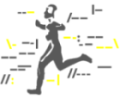





Search | Sitemap | Navigation |  |
|
||||||||||||||||||||||||||
|
||||||||||||||||||||||||||
|
||||||||||||||||||||||||||
|
| Markus Dahlem |
James A. Reggia

James A. Reggia, Department of Computer Science, University of Maryland.
The computational perspective on brain disorders is a natural one for James A. Reggia, who is a professor in the Department of Computer Science at the University of Maryland with a joint appointment in Neurology. In the mid 90s, Reggia and Montgomery (1996) started their investigations on migraine aura from the hypothesis that the positive visual hallucinations are caused by the initial excitation of cortex during cortical spreading depression (CSD). To test this controversial hypothesis, they used a computational model. This multidisciplinary approach was taken because this hypothesis can not readily be tested in animals or humans.
They created a reaction-diffusion wave model based on potassium dynamics, similar to the first CSD model suggested by Hodgkin (as reviewed in Dahlem and Müller, 2004), and included a second dynamic variable describing a resequestration phase. This system was then connected to a neural network. Both, the reaction-diffusion system and the neural network were not initially developed to study migraine aura. With the reaction-diffusion system they could test the role of CSD in the temporal evolution of damage in ischemic stroke. The neural network was originally used to study cortical dynamics and sensory map reorganization.
A distinguishing and novel feature of their aura model is that they connected two systems to a hybrid model. Others (Ermentrout and Cowan, 1979; Bressloff et al., 2002) have considered a continuum limit of neural network models to model hallucinatory patterns. However, in such models neither cortical excitation patterns in the range of hypercolumn spacing nor diffusion limited spread (in the range of mm/min) can be studied. Therefore the model of Reggia and Montgomery was much more suited for studing the typical fortification pattern.
The key result of their simulations is that on the leading edge of the potassium wave, the elsewhere largely uniform neural activity was replaced by a pattern of small, irregular patches and lines of highly active elements. They have built the first computational model that can reproduce the typical zigzag of a fortification pattern. The model predicts zigzags as excitation patterns on the cortical surface that are then simply remapped onto the visual hemifield to simulate the fortification pattern.
Cover of Disorders of Brain, Behavior and Cognition: the Neurocomputational Perspective, 1999.
Understanding brain and cognitive disorders: the computational perspectiveBy E. Ruppin, J.A. Reggia and D. Glanzmann"The last decade has witnessed an increasing interest in computational investigations of brain functioning. It is only natural to ask how such neural modeling may be harnessed to investigate the pathogenesis or potential treatment of brain disorders, and in what way may computational methods complement more traditional research methodologies. ..." Quote from the introduction of the book "Disorders of Brain, Behavior and Cognition: the Neurocomputational Perspective" Prog Brain Res 121, 1999. |
References
Bressloff PC, Cowan JD, Golubitsky M, Thomas PJ, Wiener MC. What geometric visual hallucinations tell us about the visual cortex. Neural Comput 2002; 14: 473-491.
Dahlem MA, Müller SC. Reaction-diffusion waves in neural tissue and the window of cortical excitability. Annalen der Physik 2004; 13: 442-449.
Ermentrout GB, Cowan JD. A mathematical theory of visual hallucination patterns. Biol Cybern 1979; 34: 137-150.
Reggia JA, Ruppin E, Glanzman DL (Eds). Disorders of Brain, Behavior and Cognition: the Neurocomputational Perspectiv Elsevier Science, Prog Brain Res 121, 1999.
Reggia JA, Montgomery D. A computational model of visual hallucinations in migraine. Comput Biol Med 1996; 26: 133-141.
Author: Markus Dahlem
Last modification of this page: Friday March 25. 2005
| Markus Dahlem |
 Top of the page
Top of the page| · | News |
| · | Medical Professionals |
| · | Medical Studies |
Copyright © 2005 Migraine Aura Foundation, All rights reserved. Last modification of this site: August 25, 2006
Thanks to: RAFFELT MEDIENDESIGN and GNU software | webmaster@migraine-aura.org
http://migraine-aura.org/EN/James_A_Reggia.html



